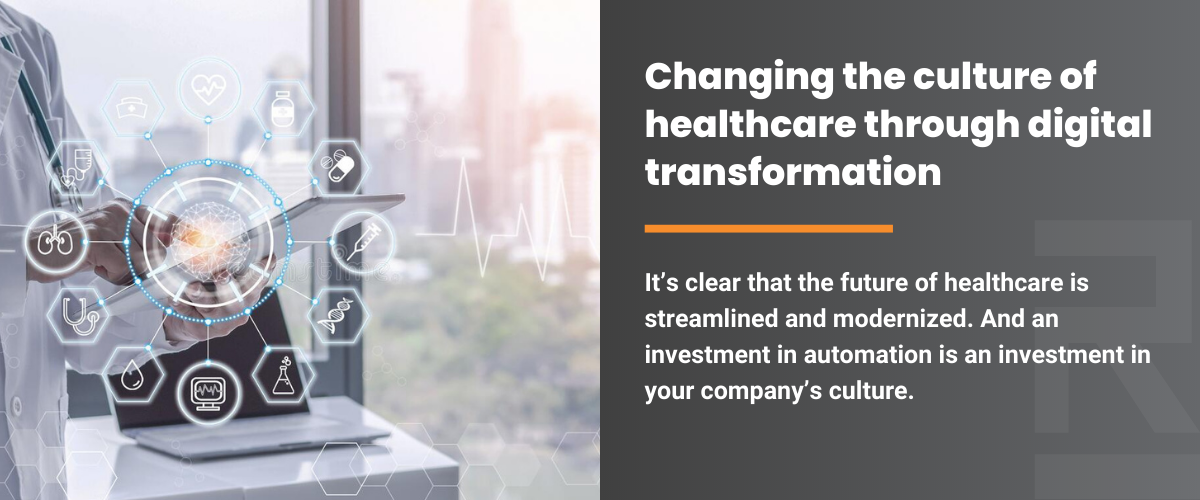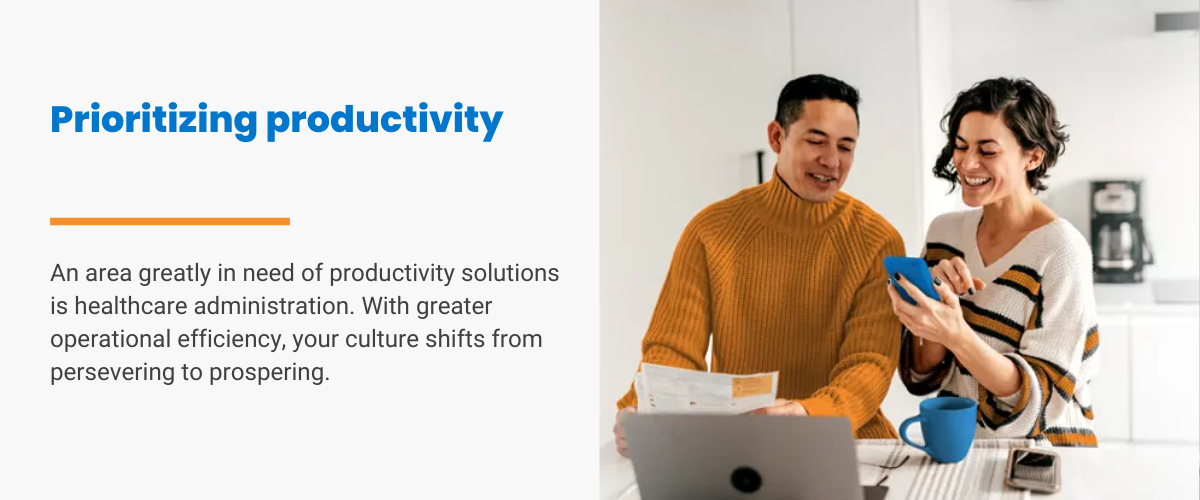Company culture — your values, practices, and overall narrative — is an essential element of all healthcare organizations. As a leader, you lay the groundwork for your company culture and nurture its growth and development.
Successful organizations build a positive company culture that engages employees and helps them thrive. But this is no easy task. A 2021 Gallup report found that only 34% of U.S. employees are engaged in their work. People are also leaving their jobs in droves. The Bureau of Labor Statistics reports the number of Americans who quit their jobs reached a record high of 4.5 million in November 2021.
To some extent, this decline in employee retention reflects a culture mismatch. Workers are willing to leave employment to find a company that better matches their character. While you can’t be all things to all people, you can invest in your company’s culture to attract and retain the most talented employees.
One strategy for improving culture is automation.

Changing the Culture of Healthcare Through Digital Transformation
The pandemic has spurred a technology revolution. The McKinsey Quarterly reports that e-commerce saw an equivalent of 10 years of growth in a few short months during 2020.
The healthcare industry experienced a similar trend. BDO’s 2021 Healthcare Digital Transformation Survey reported that 93% of healthcare organizations were adding new digital projects. “From telehealth to remote patient monitoring, online patient portals to drive-through clinics, healthcare underwent a decade’s worth of transformation in an instant,” the report says.
As healthcare systems deal with these rapid changes, the culture is shifting throughout practices and organizations. According to Accenture, the accessibility of technology is democratizing the workplace, which opens up opportunities for employees to provide input to management for process improvement throughout organizations. In fact, over 90% of healthcare executives believe democratization – soliciting valuable feedback from employees on what they do and how to do it – is key to igniting innovation. For example, automation technology empowers office staff to focus more on compassionate care, rather than manual tasks. Leveraging the digital tools found within unified systems, office staff can better manage their own workloads, which in turn, allows healthcare practices to deliver even more exceptional patient experiences.
It’s clear that the future of healthcare is streamlined and modernized. And an investment in automation is an investment in your company’s culture.
Valuing Employee Well-being
Employee satisfaction is a key component of company culture. Most employees want challenging work that gives them a sense of purpose.
Unfortunately, tedium is common in the workplace. A survey by Smartsheet found that more than 40% of U.S. workers spend at least a quarter of their time on manual, repetitive tasks. Those surveyed were overwhelmingly positive about the opportunities that automation can bring:
- 86% said automation could help them be more efficient and productive
- 78% said automation would allow them to spend more time on the stimulating aspects of their job
- 72% said they would perform higher-value work with the time saved through automation
Analysts at McKinsey Global Institute estimate that more than a third of the work in healthcare settings could be automated. This includes tiresome administrative tasks such as registering patients and taking patient payments. By easing the burden of performing these tasks, you can boost your employee’s morale and well-being.
An upbeat staff has the potential to deliver additional benefits such as greater collaboration and improved patient care.
Prioritizing Productivity
As one of the main drivers of profitability, healthcare leaders are continually striving to enhance workplace productivity.
An area greatly in need of productivity solutions is healthcare administration. The Brookings Institution estimates that administrative costs now account for over one-quarter of healthcare spending.
The good news is that many administrative functions can be computerized, such as:
- Patient communications: This includes sending out appointment and billing reminders.
- Registration: Patients should be able to complete their own registration forms online.
- Revenue cycle management: Digital technologies for sending out billing statements, collecting patient payments, and posting payments can replace manual processes.
With greater operational efficiency, your culture shifts from persevering to prospering.
Promoting Employee Growth
For your organization to grow, your employees must have opportunities to grow as well. Does your company culture encourage employees to acquire new skills? If so, how do they find time to participate in training programs?
A survey by LinkedIn found that 94% of employees would stay at a company longer if it invested in their career development. At the same time, the survey listed “finding time for learning” as the top challenge in developing talent. Automation provides the time employees need to upskill and reach their full potential.
Enhancing the Patient Experience
Customer service is embedded in the culture of all healthcare organizations. Digital solutions can enhance patient satisfaction by giving them the options they want and eliminating points of friction.
Areas where technology can improve the patient experience include:
- Patient payments: A study by CWH Advisors found payment preferences are shifting toward online and digital wallet options. Consumers of all ages want the ease and agility to pay with a click or tap.
- Communication: These days, patients prefer text messages to phone calls and voice mails. With the right technology, healthcare providers can meet these expectations when communicating about bills, payments, and appointments.
Embracing the New Remote Work Environment
The mobile office has suddenly become part of company culture. A recent survey by Akasa found that about one-third of companies are shifting staff to remote work for the long term.
This transition is not possible without technology. Cloud-based software supports the off-site worker by providing secure access and a web-based interface. It also eliminates manual, office-based tasks such as mailing paper billing statements and handling checks and cash.
Accenture reports that 55% of healthcare organizations invested in digital tools to support remote work during the pandemic. Now is the time to reassess these investments in the context of your future goals.
Streamline Payment Processing with Rectangle Health
For nearly 30 years, Rectangle Health has helped thousands of hospitals and medical practices build streamlined systems for payment processing. Through our leading platform, Practice Management Bridge®, we offer a collection of automated solutions that can help you improve office efficiency, financial stability, and the patient experience.
With contactless payments such as Text-to-Pay, online payments, and Card on File, your staff saves precious time and your patients have the digital payment options they want. Practice Management Bridge also enhances provider-patient communication with digital registration forms and custom text messages.
At Rectangle Health, we believe implementing new payment technologies should be as smooth as possible for our clients. That’s why we designed Practice Management Bridge to interface seamlessly with your existing practice management system or electronic medical record.
References
- Gallup. (2021). State of the Global Workplace. 2021 Report. Retrieved online February 20, 2022, from https://www.gallup.com/workplace/349484/state-of-the-global-workplace.aspx?thank-you-report-form=1.
- US. Bureau of Labor Statistics. (2022, January 4). Job Openings and Labor Turnover Survey News Release. Retrieved online February 20, 2022, from https://www.bls.gov/news.release/archives/jolts_01042022.htm.
- McKinsey Global Institute. The Quickening. Retrieved online February 20, 2022, from https://www.mckinsey.com/capabilities/strategy-and-corporate-finance/our-insights/five-fifty-the-quickening.
- BDO. (2021, January). 2021 Healthcare Digital Transformation Survey. BDO Center for Healthcare Excellence & Innovation. Retrieved February 20, 2022, from https://www.bdo.com/insights/industries/healthcare/2021-healthcare-digital-transformation-survey.
- Accenture.(2021, June 7). I, technologist. Retrieved February 20, 2022, from https://www.accenture.com/us-en/insights/health/i-technologist.
- Smartsheet. (2017). Automation in the Workplace 2017. Retrieved online February 20, 2022, from https://www.smartsheet.com/sites/default/files/smartsheet-automation-workplace.pdf.
- McKinsey Global Institute. A Future That Works: Automation, Employment, and Productivity. Retrieved online February 20, 2022, from https://www.mckinsey.com/~/media/mckinsey/featured%20insights/Digital%20Disruption/Harnessing%20automation%20for%20a%20future%20that%20works/MGI-A-future-that-works-Executive-summary.ashx.
- The Brookings Institution. (2020, March 10). Reducing administrative costs in US health care. Retrieved online February 20, 2022, from https://www.brookings.edu/articles/reducing-administrative-costs-in-u-s-health-care/.
- LinkedIn. 2018 Workplace Learning Report. Retrieved February 20, 2022, from https://learning.linkedin.com/content/dam/me/learning/en-us/pdfs/linkedin-learning-workplace-learning-report-2018.pdf.
- AKASA. (2021). Annual Report on Automation. AKASA. Retrieved February 4, 2021, from https://akasa.com/platform-overview/
- Accenture. (2021, June 7). Anywhere, everywhere. Retrieved February 20, 2022, from https://www.accenture.com/us-en/insights/health/anywhere-everywhere.



